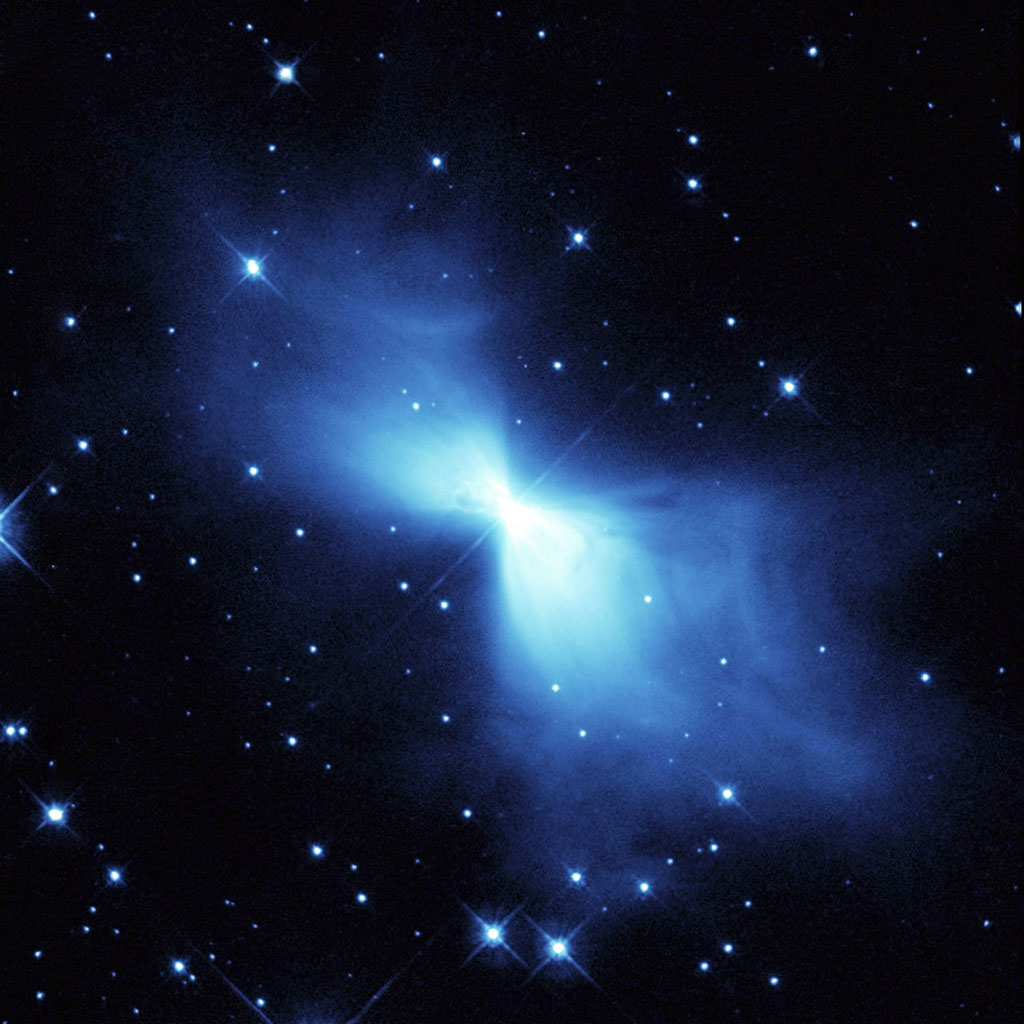N 81 is a cloud of reddening gas, which shelters from young and brilliant stud.
The reddish glow of this nebula is the result of the ultraviolet radiation emitted by its most brilliant two stars, 300 000 times as brilliant as the Sun.
N 81 is in the Small Cloud of Magellan, itself small satellite galaxy of the Milky Way.
The recent and massive stars inside N 81 lose their matter very quickly, creating powerful solar winds and shock waves drilling the cocoon of the outside nebula. The most brilliant both stars seen on the image of Hubble under the shape of a pair very moved closer near the center of N 81 emit strong ultraviolet radiations, returning the fluorescent nebula.
The images sent by Hubble show " that a heap of young massive stars is destroying its native cocoon.
The small Cloud of Magellan (PNM), named according to the name of the explorer Ferdinand Magellan, is in 200 000 light years and is visible only since the southern hemisphere of the Earth.
N 81 is the 81st nebula cataloged in a study on the PNM driven by the astronomer Karl Henize in 1950, which afterward stole in the Space shuttle at time that astronaut. The presented image is a color representation of data obtained in September, 1997 with the camera WFPC2 of Hubble.

The Tarantula Nebula is a gigantic factory of manufacturing of stars. It is the biggest nebula of known emission.
Placed at a distance 170 000 light years, she can be observed in the constellation of the Sea bream in the southern sky.
It belongs to one of the nearby galaxies of the Milky Way, the Big Cloud of Magellan.
The Nebula of the Tarantula contains more than half a million times the mass of the Sun, this vast and blazing cloud welcomes some of the most massive known stars.
The nebula owes its name to the arrangement of its most brilliant sectors which look like in a sense the legs of a spider.
They extend since a central "body" where a heap of warm stars (conscript R136) illuminates and structures the nebula.
This name of one of the biggest spiders ground, was chosen because of the colossal proportions of the nebula indeed, it measures almost 1 000 light years of wide and extends over more than a third of degree, is approximately the size of the full moon.
If it was situated in our own galaxy, at the distance of another stellar nursery, the Nebula of Orion (distant from only 1 350 light years), it would cover a quarter of the sky and would be visible even in broad daylight.
The astronomers realized this mosaic of four images to obtain a sight covering a square degree.
Every individual image containing 64 million pixels, the resultant mosaic contains 256 million pixels.
The image is based on data collected through four filters, among which two which draw the hydrogen (in red) and the oxygen (in green).
The ascendancy of the green in the image of the Tarantula results from the presence of the youngest and the warmest stars in this region.
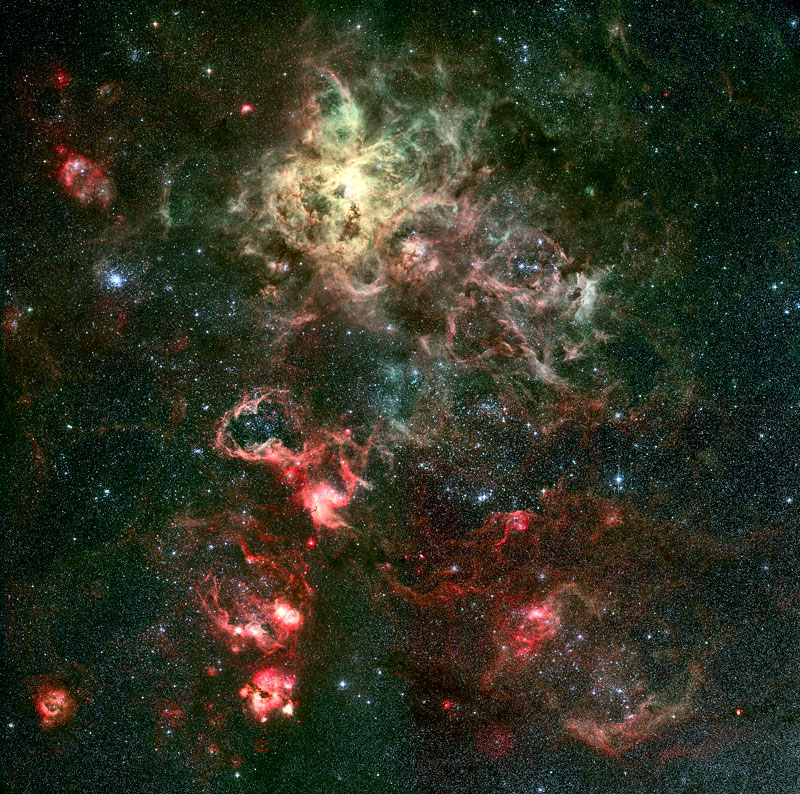
The butterfly nebula is situated in the approximately 2 000 years light of the Earth in the direction of the constellation of the Unicorn.
It is the last moments of the spectacular system of binary stars that we see on the photo opposite in the center of the nebula.
These two stars are so close as they orbit the one around the other one in 16 days. Even with Hubble, the pair of stars cannot be seen as two separate constituents.
The astronomers think that one of the stars, by evolving developed to become a red giant and literally absorbed her companion.
Stars swirled together in spirals, and most of the external layers of the red giant were ejected in a dense disk which surrounds now the central star.
The nebula is also rich in clouds of dust, among which some form of long streak sink who point far from the central star.
The spatial telescope Hubble arrested this image of the nebula in shape "of wing of butterfly", NGC 2346.
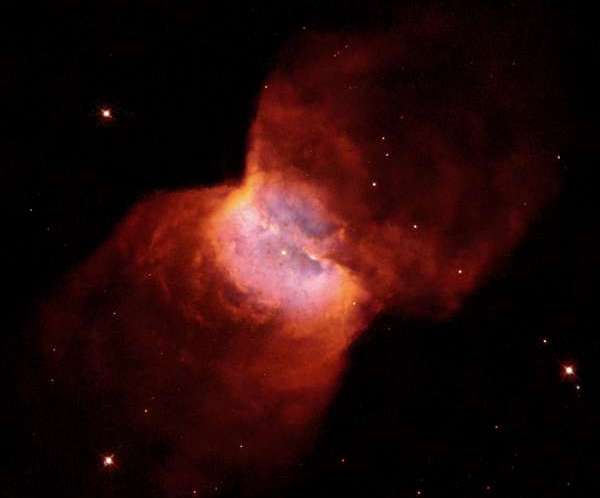
The Horsehead nebula (officially known under the name of Barnard 33; IC434 is a dark nebula in the constellation of Orion.
The nebula is just below Alnitak (ζ Ori), the star most east of the belt of Orion. This nebula, situated in 1 350 light years was discovered for the first time in 1888 on a photographic plate taken in the look-out observatory of Harvard College.
It is easily recognizable by the shape at the head of horse which gave it its name. Indeed, behind the nebula is some hydrogen which, ionized by the brilliant star close Sigma Orionis, gives a red color.
The darkness of the head of horse is caused by the presence of a dense cloud of gas and dust.
This last one absorbs strongly the visible radiation emitted by the gas ionized by back plan (red on the photo). On the base of the head, we find young stars in the process of formation.
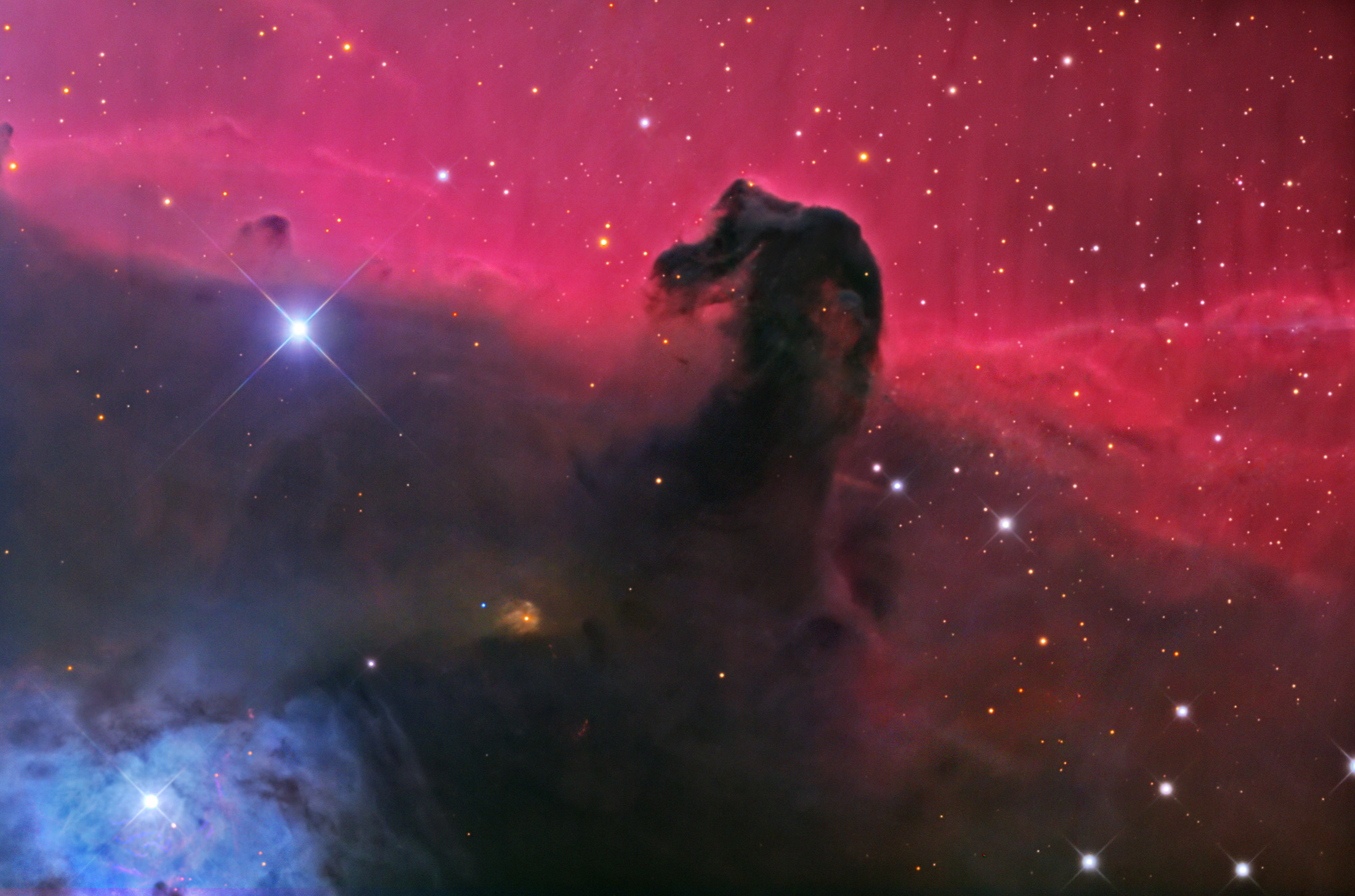
The planetary nebula NGC 2818 is nested inside the open cluster NGC 2818A Star and has a visual magnitude of 8.2 and therefore invisible to the naked eye. The cluster and nebula are more than 10,000 light-years away in the southern constellation Pyxis called Compass. The colors seen from the various components more or less ionized in which each emit a wavelength-kind. The colors in this image represent a range of emissions from clouds of the nebula.
Red represents nitrogen, green represents hydrogen, and blue, oxygen. The name "planetary nebula" comes from the first observations of these objects, which sometimes have a circular appearance, like a planet.
In reality it is star reached the end of life, violently expelled in the form of gas, much of the material they are made. The planetary nebula NGC2818 is detached from the surrounding stars. This Hubble image was taken in November 2008 with the WFPC2 instrument (Wide Field Planetary Camera 2).

The planetary nebula NGC 2392 or the Eskimo, was discovered in 1787 by astronomer William Herschel in the constellation Gemini.
NGC 2392 looks like a head surrounded by a parka. This nebula consists of two discs, the inner disk bright enough and the outer disc ring-shaped irregular.
NGC 2392 is at a distance of approximately 4000 years light.
There are only 10 000 years, gas visible on the image below against constituted the outer layers of a sun-like star. The central star is clearly visible in this image.
The internal filaments visible in white were ejected by strong wind of particles from the central star.
The outer disk contains filaments of orange color, a light-year long.

Planetary nebulae are simple spheres shaped planet when viewed through a small telescope. But the Hubble Space Telescope is able to show us the details of his celestial objects.
Planetary nebulae have spherical shapes varied, are fluorescent balls of gas expelled by a central star at the end of life.
This Hubble image is a composite colored example of a planetary nebula, but with complex characteristics. This image of NGC 6751 was selected in April 2000 to commemorate the tenth anniversary of Hubble in orbit. The colors were chosen to represent the relative temperatures of gas (blue, orange and red, the hottest gas gas coldest).
These are the winds of intense heat and radiation from the central star that create the characteristic shape of the nebulae.
The central star dying, shines as Suns 9000. It expels its outer gaseous layers and exposes its core burning whose strong ultraviolet radiation illuminates the ejected gas.
The diameter of the nebula is about 0.85 light-years, or about 600 times the size of our solar system. NGC 6751 is 6500 light-years from us in the constellation of the Eagle.
NB: NGC (New General Catalog) is one of the best known catalogs in the field of amateur astronomy with the Messier catalog.
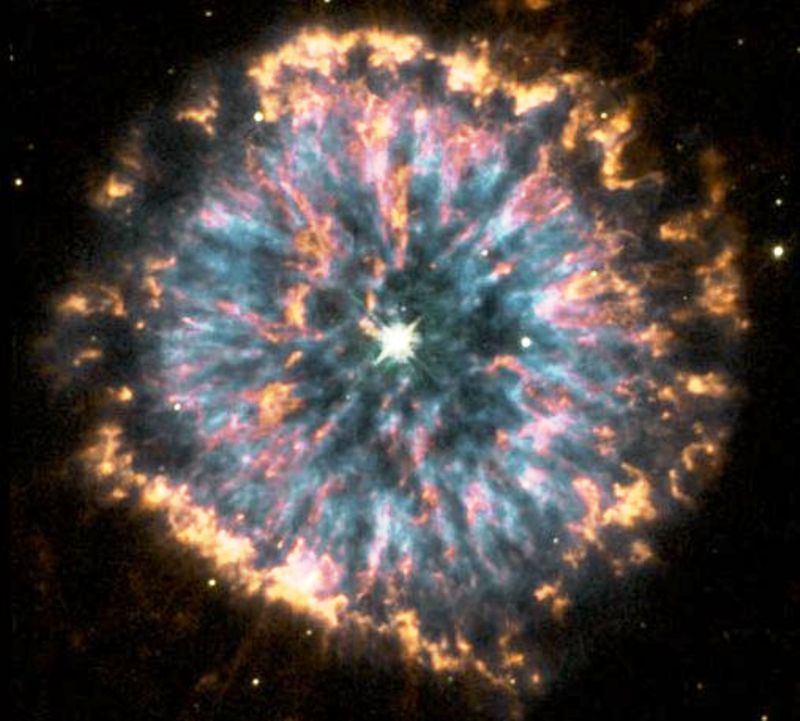
The Boomerang Nebula is a young planetary nebula located in the constellation Centaurus 5000 light years from the solar system. The central star but still light at the end of life, expels its shell of gas and dust in the cold space. These gases form a cloud of material which extends around the star like butterfly wings. This nebula is officially known to be the coldest object in the Universe. Indeed, the global temperature has been measured at 1 ° Kelvin (1 degree above absolute zero, which is even colder than the temperature of deep space, diluted and cooled by the expansion of the Universe, it has a temperature of 2,728 K (-270.424 ° C). This information was revealed in 1995 by two astronomers Sahai and Nyman who observed the nebula with submillimeter telescope 15 meters located in Chile. Form diffuse node butterfly makes it very different from other planetary nebulae usually resemble colorful diffuse disc or bubbles blown by a dying central star. However, the Boomerang Nebula is so young that she did not have time to develop this round structure.
The general shape of butterfly wings appear to have been created by an excessively strong wind blew the gas far from the central star. It is this rapid expansion of the nebula that cools the gas to reach this incredible temperature of 1 ° K. The blue color of the image is from light reflected by the star dust particles plant.
